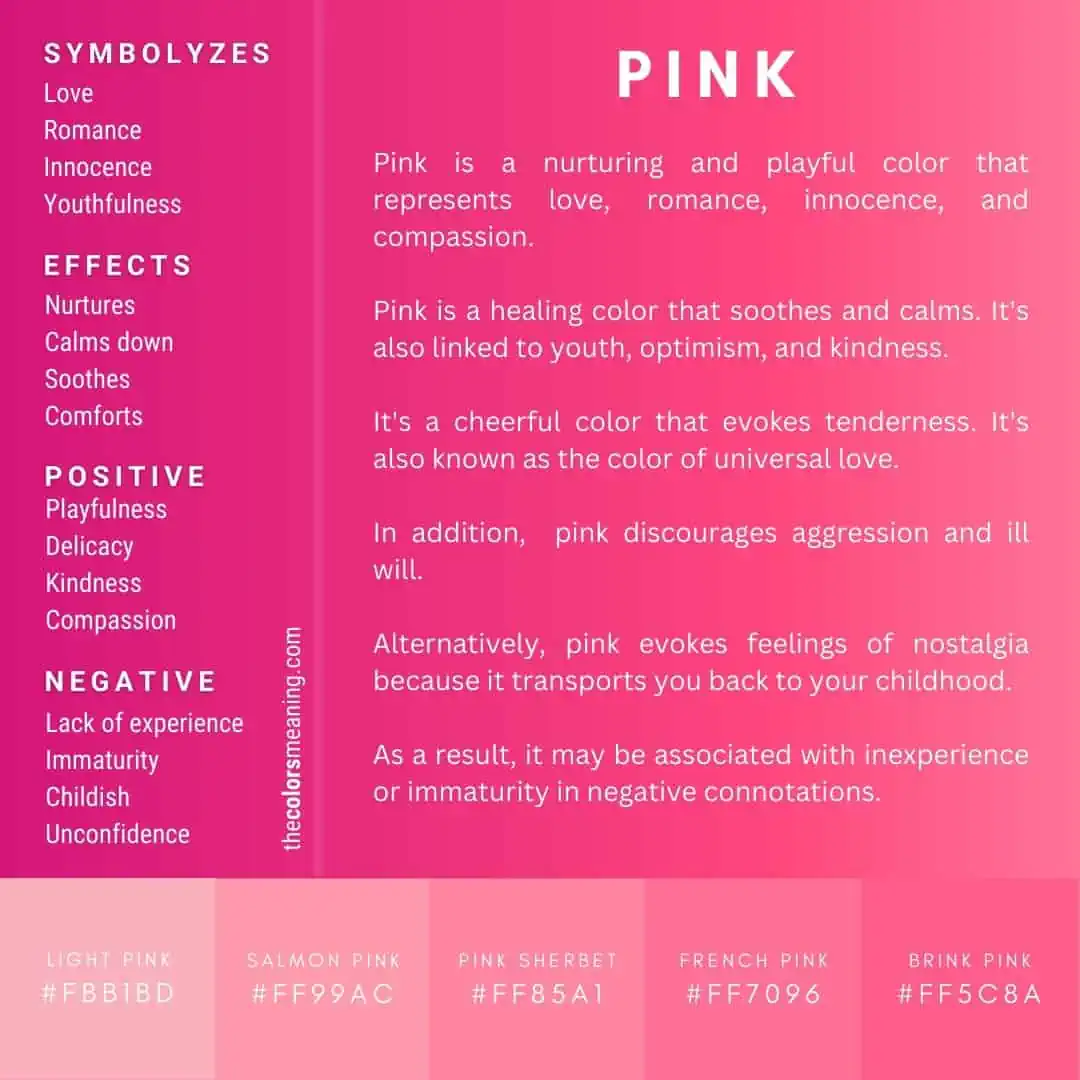In today’s article, we’ll look at the symbolism and meaning of the color pink.
Where may the meaning of pink be found?
Is it in pink roses, the lovely pink of pink Chinese cedars, or the well-known pink of chewing gum?
Or is it found in the fruity odor of raspberries or the lovely rose tulips?
Fortunately, nature provides us with the most amazing pink meanings. It is, without a doubt, the most delicate color on the color wheel.
What’s more, optimists are said to view the world through “rose-colored glasses.” Do you believe it’s a coincidence? Most likely not! Pink is said to discourage aggression and ill will.
As a result, this article will provide an overview of the symbolism and meanings of the color pink. You will also learn about the psychological and spiritual meanings of pink, as well as its uses, brand logos, chakras, gemstones, idioms, and facts.
Pink Color Meanings in Other Cultures
- In Western cultures, pink is associated with femininity. Some people believe it foretells the birth of a daughter. Pink also represents childhood and fun.
- In Latin America, pink is frequently used as a painting color for buildings and is associated with architecture.
- Pink symbolizes trust in South Korea.
- Pink did not exist in Chinese culture until Western influence made its mark.
- Pink is the color of Tuesday in Thailand. Each day of the week is represented by a different color in traditional Thai beliefs. It is said that wearing the day’s color will bring you good luck.
- In India, the main male players (the groom’s father and brother) wear pink turbans at wedding ceremonies.
- In Japan, pink is extremely popular and is worn by both men and women.
- In Eastern cultures, the color pink signifies femininity. Pink is also associated with marriage.
- In Switzerland, prison cells are colored pink. You may be wondering why. Pink reduces anger and physical strength. Pink has also been shown to have a beneficial effect on suicide rates. Al Capone’s cell was even pink.
What Does the Color Pink Mean in the Bible?
Pink, according to historians, is a symbolic color in the Bible, representing the spiritual union between God and people. As a result, in the Bible, the color pink is associated with having a good relationship with God.
Pink is created by combining white and red. White represents purity and is associated with the Higher Self. Red is associated with people’s Aggressive Passions.
People’s relationship with God is explained as a sign of joy (Psalm 32:11, Nehemiah 8:10) and passion for Jesus (Song of Songs 1:2).
Another spiritual significance of pink relates to New life and the heavenly care of the Father.
Psychological Meaning of Pink
Pink is the result of mixing red and white, so it has characteristics of both colors.
As a result, red is associated with action, energy, passion, and bravery. Moreover, it can also be associated with rage, danger, and aggression. Pink has borrowed energy and passion from the meanings of this color.
White represents purity, serenity, simplicity, innocence, and cleanliness. Yet, it can appear empty, distant, or cold at times. Thus, pink has borrowed white’s purity and tranquility.
Pink is a charming color with calming properties. In Morton Walker’s book “The Power of Color,” Dr. Schauss noted that even if a person attempts to be furious or violent in the company of pink, he can’t.
A study on prisoners’ reactions to a shade of pink has been published by the director of the American Institute for Biosocial and Medical Research in Tacoma, Washington (Baker-Miller pink). Pink was found to have calming effects on violent prisoners. [1]
Pink has been used in schools and correctional institutions to reduce suicide rates because it reduces anger and physical strength.
In addition, Iowa coach Haden Fry painted the visiting team’s locker room pink to induce lethargy and calmness. Clever, isn’t it? It is not a coincidence. The coach has a master’s degree in psychology from Baylor University.
Pink is not only passive; it also soothes and calms. Moreover, the color pink discourages aggression and promotes kindness.
Pink is nurturing and has a strong connection to compassion.
The color pink is recommended for room painting in chromotherapy for people who have difficulty calming down. As a result, pink is a cheerful color that deters aggression.
Color Pink Meaning
Pink is a caring and loving color that promotes harmony and exudes compassion and kindness.
Pink, as an extremely affectionate color, demands attention and support. That is why people who wear predominantly pink need attention.
Pink is associated with feelings of love and sympathy. It is the color of unconditional love, seeking attention and support.
Pink is also a nostalgic color that transports you back to your childhood. It is a nurturing and playful color that represents youth and innocence.
Pink is also a contrasting color because it evokes passion and innocence.
Pink, on the other hand, is associated with romance, charm, and innocent love, as opposed to red, which is associated with a burning passion.
The color pink is the playful, romantic, and sweet side of red. While light pinks are associated with tenderness, hot pinks are associated with playfulness.
Pink is an extremely attractive color for women for these reasons. It is delicate, gentle, romantic, and innocent.
Pink can lift one’s spirits by evoking feelings of hope, sympathy, and optimism. Moreover, it conveys the message that nothing is impossible.
Pink has a positive emotional impact because it is associated with cheerfulness and happiness. Furthermore, it has an uplifting and inspiring effect.
Pink, as a symbol of kindness, exudes warmth and comfort. It also improves intuition and the creative side.
It is a vibrant, bright color that adds a smart and chic touch to any soul.
Pink, on the other hand, has negative connotations. Due to its association with childhood, pink is perceived as lacking in experience.
Pink is the most passive of all colors, encouraging friendliness while discouraging aggression against oneself and others.
Furthermore, because pink is derived from the color red, which is associated with passion and aggression, excessive pink can cause physical weakness.
Pink also evokes nostalgia and passivity and, if worn excessively, can keep you stuck in the past.
However, when combined with the right hues, pink is a nurturing color that conveys youth, warmth, compassion, and thoughtfulness.
Color Pink Spiritual Meaning
What does the color pink mean spiritually? Pink is said to be a healing color that is closely related to the heart chakra in the healing world.
The ability to receive and give unconditional love is governed by this chakra.
Furthermore, it is linked to our ability to express ourselves. That is why it is critical to keep this energy center balanced and open. When it is open, we experience calm and inner peace.
Pink is also associated with the water element, which is associated with emotions. When our emotions are in balance, we are better able to deal with difficult situations.
The spiritual meaning of pink is also associated with nurturing, caring, and unconditional love.
Pink’s soft hue helps us to open our minds and hearts to new possibilities. It is also associated with optimism and hope.
Physical Effects of Pink
Pink has a variety of temporary physical effects on the body:
Energizes: Pink, because it is full of life, evokes euphoria. In addition, because of the high amount of red in their composition, bright shades of pink can energize the body. A great example is shocking pink.
Relaxing: Pink is calming and soothing. It also reduces anger and has an extremely nurturing color. However, when worn in excess, it can physically exhaust you.
Comforts: Pink is a cheerful color often associated with kindness and compassion. Pink also represents comfort and warmth, in addition to hope and youth.
Cheers: Pink evokes feelings of joy and happiness and contributes to the creation of a cheerful atmosphere.
Personality Color Pink
Are you drawn to pink things?
Pink as a favorite color indicates you have a pink personality. It denotes that you are a sensitive, kind, romantic, and sensitive soul. However, you also have a sensual and charming side.
If your favorite color is pink, you can be perceived as a sensitive individual with a nurturing side.
Meaning of Pink Shades
Pink is a combination of red and white, and as such, the meanings of the various shades of pink borrow from the characteristics of both colors.
Rosewater: Rosewater pink is the color of compassion and is associated with love, tenderness, and romance.
- Rosewater hex code: #EDAEC0
Hot pink: Full of life, hot pink is associated with joy and happiness. Furthermore, it is a color that conveys playfulness and youth.
- Hot pink hex code: #FF69B4
Shocking pink: With a much higher concentration of red, shocking pink is energetic, fun, and trendy.
- Shocking pink hex code: #FC0FC0
Rose pink: Rose pink is associated with passion, desire, and emotion due to its high red content. At the same time, rose pink conveys warmth.
- Rose pink hex code: #FF007F
Fuchsia: Fuchsia is an uplifting and playful color that exudes a lot of energy. Furthermore, it exudes confidence and vitality. However, it can also have meanings of superficiality.
- Fuchsia hex code: #FF00FF
Peachy pink: Peachy pink evokes energy, playfulness, and vitality. It’s also delicate, pleasant, sweet, and welcoming.
- Peachy pink hex code: #FF9A8A
Dusty pink: Dusty pink is a softer version of pink that evokes feelings of love and femininity. Furthermore, it exudes a greater sense of maturity.
- Dusty pink hex code: #C291A4
More Shades of Pink
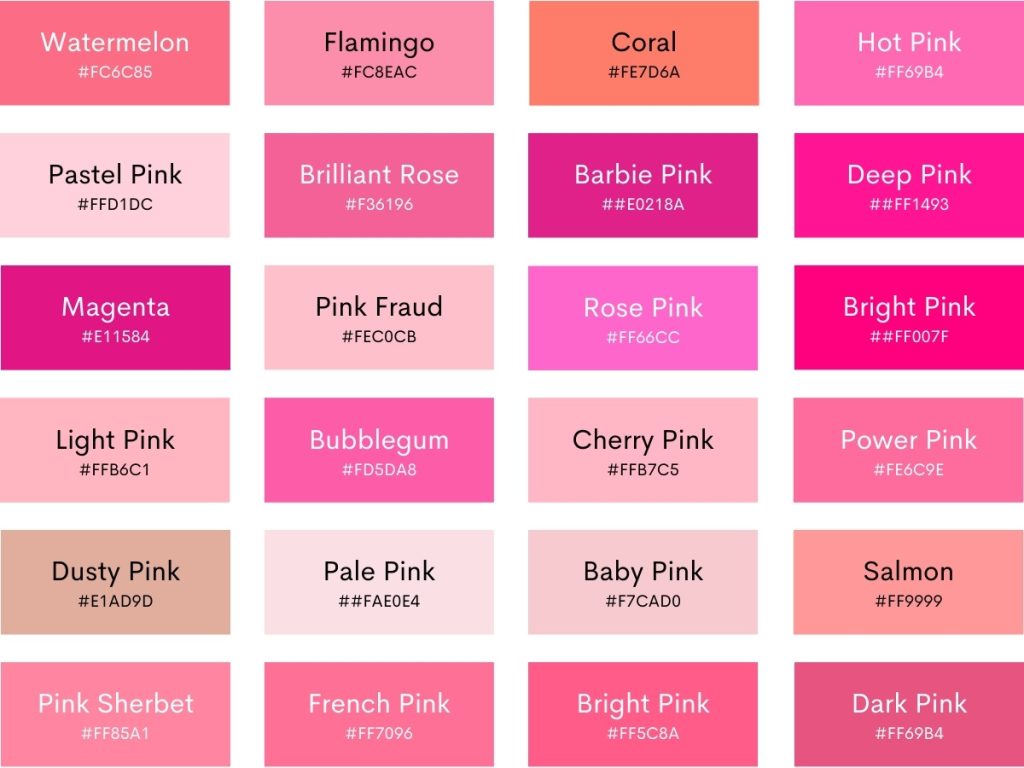
Although there are many different shades of pink, the most popular are dusty pink, pastel pink, baby pink, light pink, rose, nude pink, peach, bubblegum pink, and hot pink.
Dusty pink is ideal if you want to convey a sense of maturity. Baby pink or light pink are other cute shades that bring more innocence and purity.
Common Uses of the Color Pink
Until the 1950s, pink was the color of boys, and blue was the color of girls. Pink was thought to be a strong color, while blue was thought to be delicate, thus the association.
Men wore darker colors in the mid-twentieth century to reflect their World War II service. As a result, most pastel colors, such as pink, were considered feminine. This resulted from the postwar effort to remove women from the labor force.
Pink was later promoted and associated with femininity by companies.
Pink is thus commonly used in beauty products, toys, and girls’ clothing. For example, in the beauty industry, mass-market lines use eye-catching hot pinks to attract attention.
Pink, on the other hand, is appropriate for all genders.
Pink is used in bathroom interior design. As a result, when it comes to bathrooms, designers frequently choose pink to give the skin a luminous glow through reflection.
Companies That Use Pink in Their Logo
Pink represents friendship, childhood, femininity, kindness, and harmony.
That’s why brands frequently use pink to convey friendliness and accessibility.
In addition, brands that use bright and warm pinks in their logos convey youth and confidence.
However, most companies with pink in their logos target young people and frequently promote clothing and sweets.

Pink Gemstones
The most popular pink gemstones are pink diamond, morganite, sapphire, moonstone, tourmaline, topaz, spinel, kunzite, and rhodolite garnet.
Pink sapphire is the most sought-after of these.
Pink gemstones are said to improve one’s well-being by instilling feelings of relaxation and gratitude. Their healing properties are closely related to affection, love, and the heart chakra.
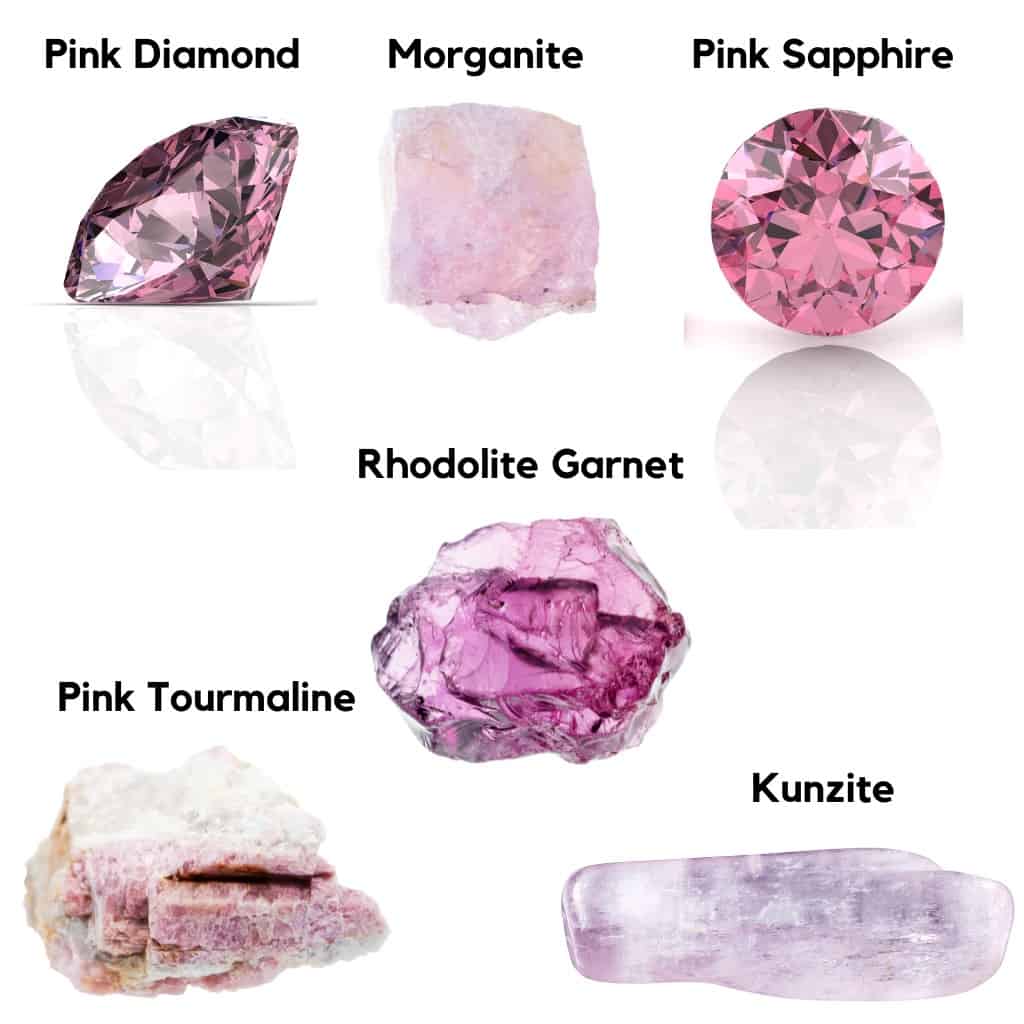
Facts About Pink
- People associate the fruity and candy odor with the color pink. [2]
- The color pink was given its name in the 17th century.
- Pink is used in prisons because it is calming and soothing. It also reduces anger and physical strength.
- The pink ribbon is a symbol of support for those affected by breast cancer. Thus, pink it’s the breast cancer awareness color.
- Pink is used in correctional facilities because it has been shown to reduce suicide rates.
- Pink was the color of men until the 1950s because it was considered a strong color, similar to the concepts of strength, energy, and action evoked by red.
- Pink was thought to aid digestion in the 18th century. As a result, the color Ashes of Roses became extremely popular.
- Self-esteem plays an essential role in men who wear pink. According to one study, men with low self-esteem felt worse after wearing pink. [3]
- Women are more likely to wear pink at peak fertility. [4]
- In terms of warm vs. cool colors, pink’s hue is red, which is warm. Pink is thus a warm color. Anyway, this is relative because magenta-hued shades are considered cool pinks.
Quotes About Pink
Pink isn’t just a color. It’s an attitude too.
Miley Cyrus
Anything is possible with sunshine and a little pink.
Lilly Pulitzer
Pink is not a color – it’s a culture to me.
DeAngelo Williams
Look on the pink side of life.
Unknown
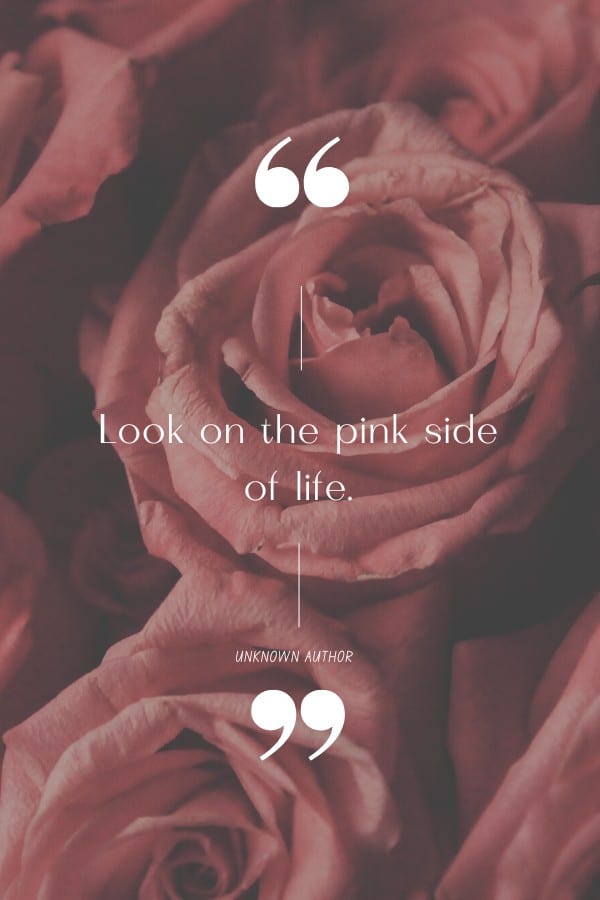
Why would anyone pick blue over pink? Pink is obviously a better colour.
Kanye West
Pink is the new black.
Diana Vreeland
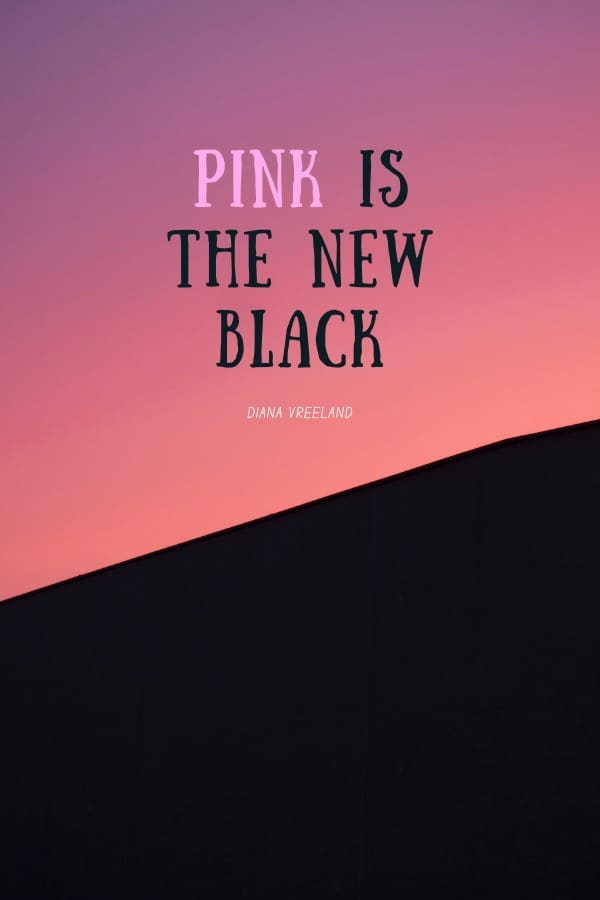
Life, when it was good, was indeed pink. La vie en rose.
Lydia Michaels
Love just comes in one color. Pink!
Anthony T. Hincks

Pink Idioms
Here are some examples of pink idioms.
- Pink elephant: It means having hallucinations due to being drunk.
- To be in the pink: It means to be in an optimal state of health.
- Get pinked: To be fired from your job. The notice comes on a pink slip to soften the blow when you get fired.
- Pink tax: It refers to a higher price usually applied to female-oriented products.
- Race for pinks: A car race in which the loser gives the vehicle to the winner. This idiom refers to the old car title certificate, which was printed on pink paper.
Summary Color Pink Meaning
Pink is a calming, soothing, nurturing, and playful color associated with warmth, kindness, and romance. Its nostalgic atmosphere frequently transports us back to our childhood. Moreover, pink is also associated with love, romance, and innocence.
Pink is more nurturing and delicate than red, which represents passionate love or burning passion.
Pink can also help with stress and anger management.
Pink means: innocence, love, romance, youthfulness
Effects of pink: nurtures, calms, soothes, comforts
Positive traits: playfulness, delicacy, kindness, compassion
Negative traits: lack of experience, childish, unconfident, over-optimism

